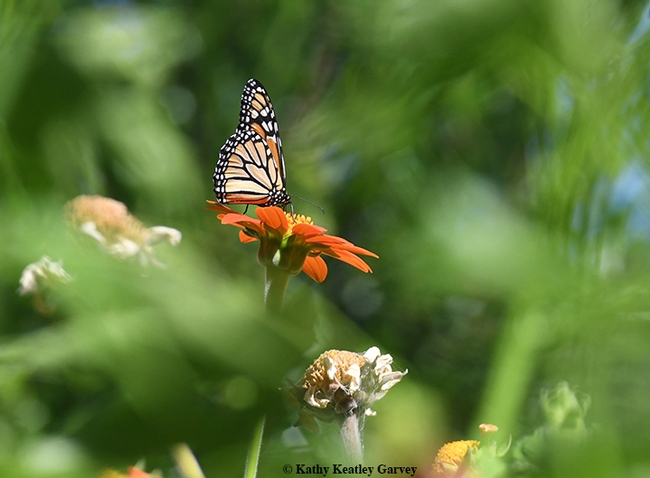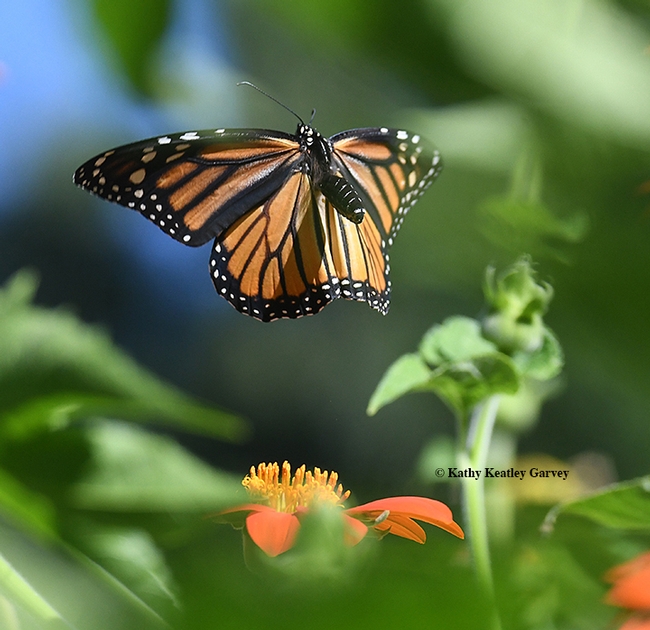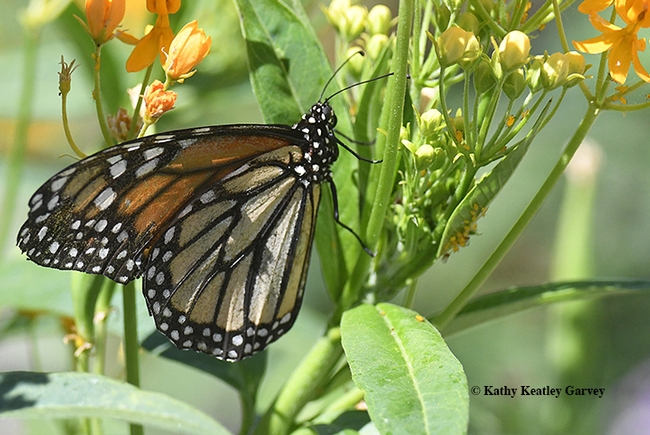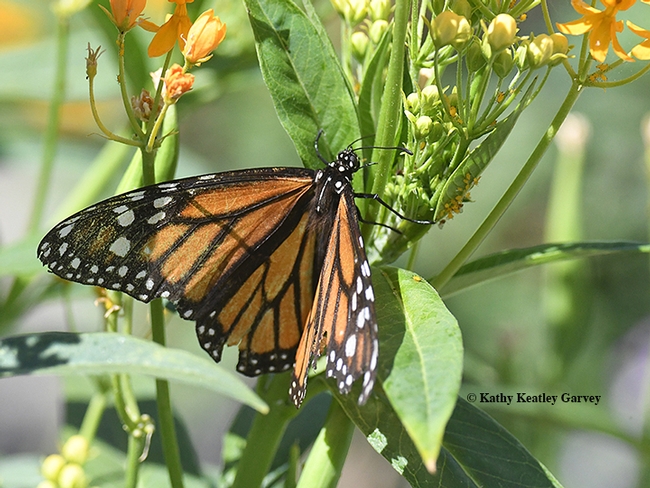- Author: Kathy Keatley Garvey
Dear Ms. Mantis,
We see you. You're trying to camouflage yourself, but we see you.
You're hanging out on a showy milkweed, Asclepias speciosa, trying to catch a butterfly or a bee.
So, will you try to nab a monarch? A Mama Monarch that's trying to lay her eggs on her host plant?
You know, the declining monarch population is on “life support,” as butterfly guru Art Shapiro, UC Davis distinguished professor of evolution and ecology, says.
Ms. Mantis, we remember when one of your kin ambushed a monarch on our butterfly bush in September of 2015. Your kin ate the head, thorax and abdomen and discarded the wings. The wings fluttered to the ground. Yes, we know you have to eat, too. Everything in the garden eats.
But now that we have your attention, Ms. Mantis, would you kindly consider the following menu--à la carte, if you wish?
- Appetizing aphids
- Scrumptious stink bugs
- Magnificent milkweed bugs
- Crunchy cabbage white butterflies
- Luscious leaffooted bugs
Thank you, Ms. Mantis, for your kind attention to this culinary matter. If we may be of any future help in menu planning (it's important to consider the principles of adequacy, balance, calorie or energy control, nutrient density, moderation and variety), please let us know.
Signed,
The Gardeners
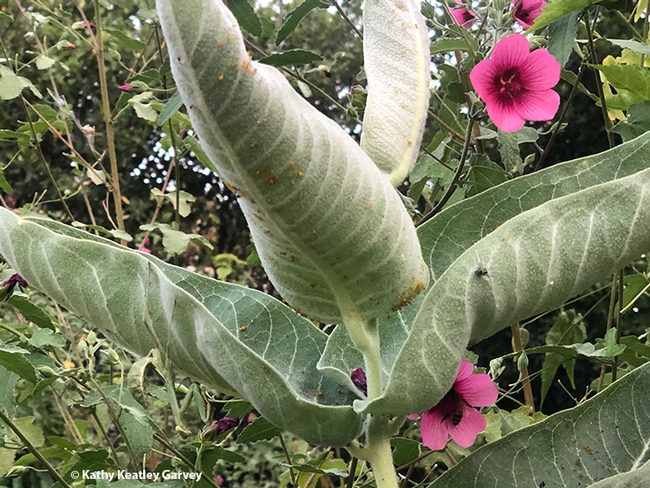
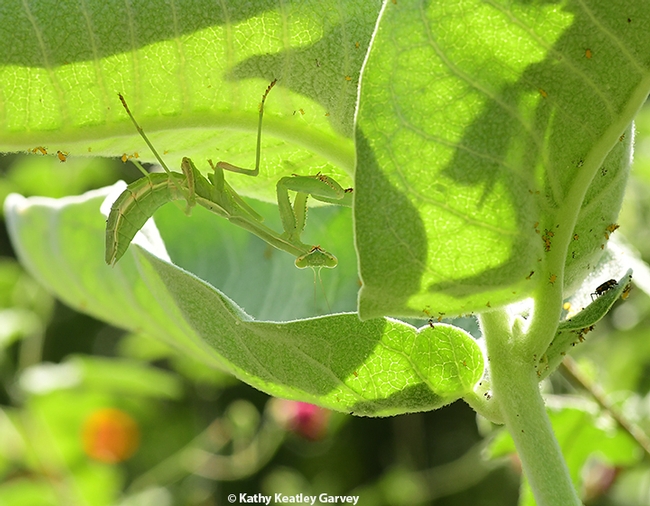
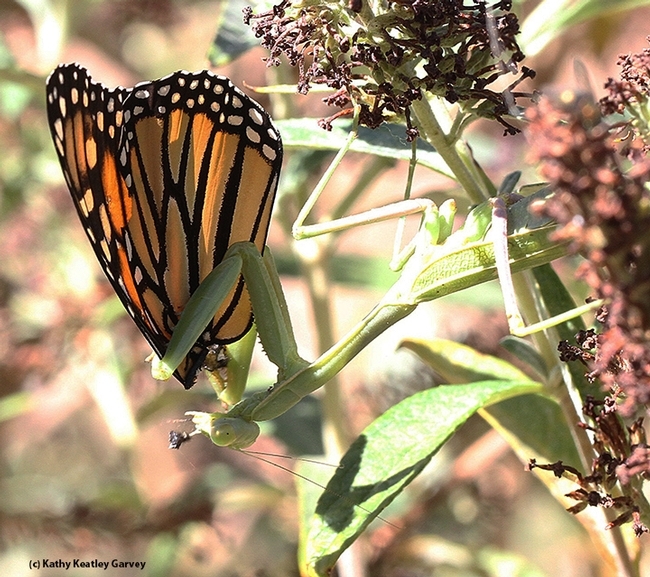
- Author: Kathy Keatley Garvey
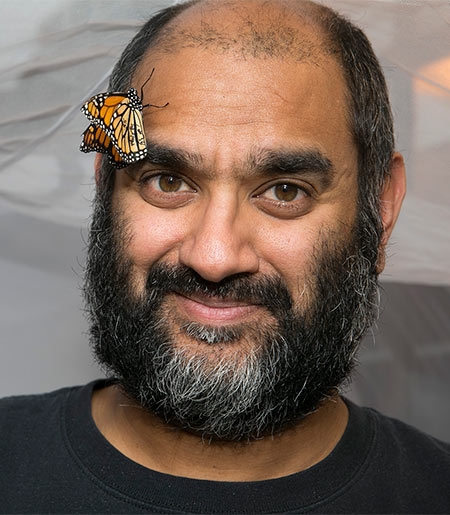
We plant three species of milkweed (the host plant for the monarchs), but both the monarchs and the honey bees gravitate toward A. curassavica, a non-native. So do syrphid flies, carpenter bees, bumble bees, leafcutter bees and assorted other insects.
If you haven't heard, planting tropical milkweed is controversial. Scientific research shows that it disrupts the monarch migration patterns when it's planted outside its tropical range, and can lead to the spreading of OE, orophryocystiselektroscirrha, a protozoan parasite that infects monarch and queen butterflies. (See Exposure to Non-Native Tropical Milkweed Promotes Reproductive Development in Migratory Monarch Butterflies, published by the National Center for Biotechnology Information, U.S. National Library of Medicine, Bethesda, Md. Also see the Xerces Society for Invertebrate Conservation website on the issue.)
UC Davis alumnus and monarch expert Anurag Agrawal of Cornell University, the James A. Perkins Professor of Environmental Studies at Cornell University and the author of the celebrated book, Monarchs and Milkweed: A Migrating Butterfly, a Poisonous Plant, and their Remarkable Story of Coevolution (2017 Princeton University), knows the controversy well.
"Tropical milkweed is an interesting and complex issue," he recently told us. "I love the plant for various reasons, but there is growing evidence that as it has become weedy (and self-seeding) in the southeastern United States and California. It is affecting monarchs, mostly by disrupting their migration. The key issue here is that when it is flowering 'out of season' this can be 'confusing' to monarchs. Having said this, we don't live in a pristine world, so my position is that we need moderation in the approach to tropical milkweed. It is certainly an easy plant to grow and monarchs can make good use of it during the caterpillar season. If you love the plant, go for it, but I would recommend cutting in back before the migratory season starts."
Agrawal received his doctorate from UC Davis. Read a review of his Monarchs and Milkweed book from the journal Ecology and read the first chapter here. You can order the book here.
Three Milkweed Species
We offer monarchs a choice of milkweed species in our Vacaville pollinator garden. In addition to the non-native A. curassavica, we plant two native species: narrowleaf milkweed, A. fascicularis, and showy milkweed, A. speciosa. In July, we collected 11 caterpillars from the narrowleaf milkweed; we rear them to adulthood and release them into the neighborhood. But in the numbers game, the tropical milkweed won. From July through today, we have collected a whopping 43 eggs or caterpillars from A. curassavica. How many from A. speciosa? Sadly, none.
As recommended, we cut back or remove the tropical milkweed before the migratory season. In the meantime, we grow it for three reasons: (1) for the monarchs (2) as a food source for other insects and (3) as an ornamental garden plant. We like the brilliant colors and the diversity of insects it attracts.
On one afternoon in late July, we photographed foraging honey bees on the spectacular blossoms. They just couldn't get enough of it.
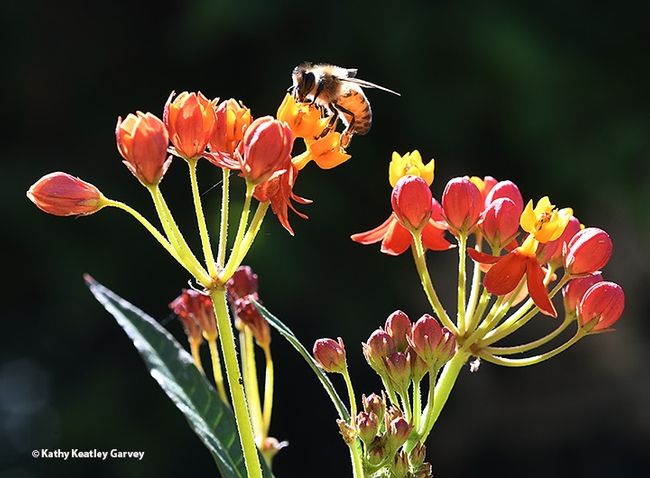
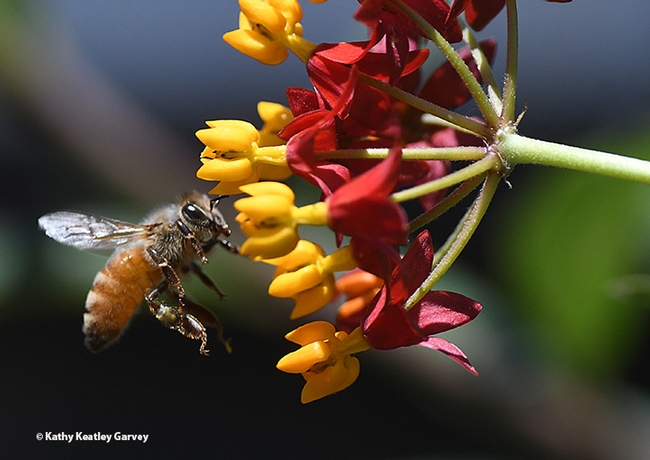
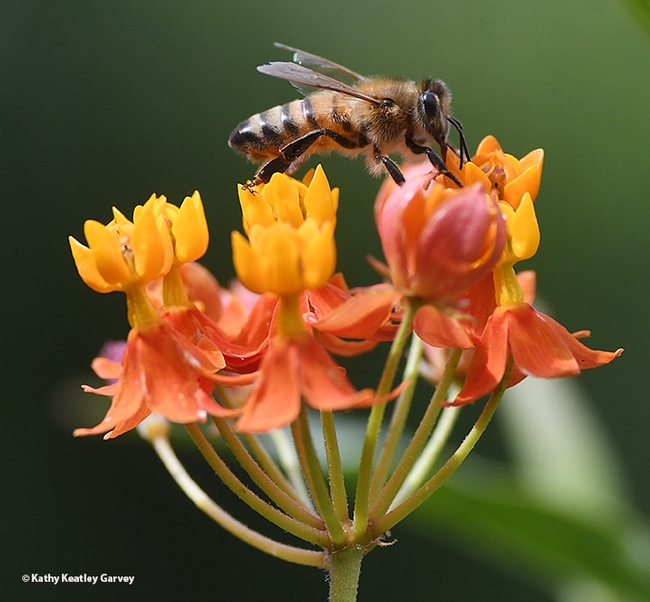
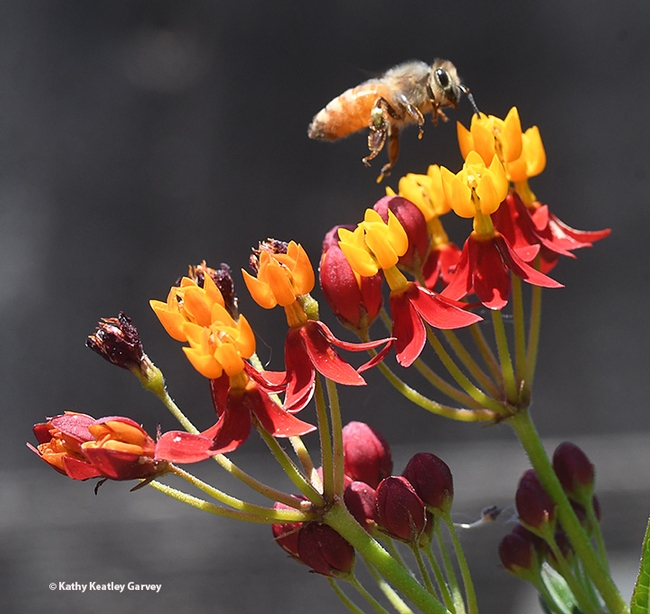
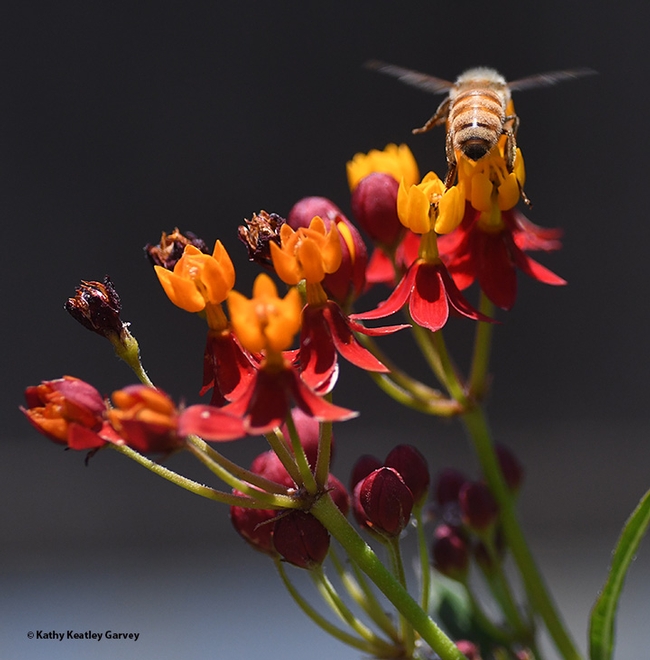
- Author: Kathy Keatley Garvey
Picture this during National Pollinator Week: five monarch caterpillars and assorted honey bees sharing tropical milkweed.
It was love at first bite. Or love at first sip.
The 'cats kept munching and the bees kept foraging. Neither species seemed interested in the other.
But the adult monarchs definitely showed more interest in the tropical milkweed (Asclepias curassavica), a non-native, than the other two species, both natives, that we planted: the narrow leaf (A. fascicularis) and showy milkweed (A. speciosa).
They laid eggs only on the tropical milkweed, and so far, have produced five caterpillars.
The score to date:
Tropical milkweed: 5 caterpillars
Narrow leaf milkweed: 0
Showy milkweed: 0
Reminder: Folks planting the tropical milkweed in temperate zones (like here in Vacaville,Calif.) must remove or cut back the tropical milkweed by winter. "A protozoan parasite of monarch butterflies, Ophryocystis elektroscirrha or OE for short, can travel with monarchs visiting the plants and become deposited on leaves," explains the Xerces Society for Invertebrate Conservation.
Yes, indeed. But meanwhile, we're witnessing untold sharing on the wildly popular tropical milkweed by not only monarch caterpillars but honey bees, syrphid flies, bumble bees, carpenter bees, leafcutter bees and sweat bees.
We gardeners and photographers are also drawn to the spectacular red, orange and yellow flowers that add both beauty and color to a cherished pollinator patch in the midst of the COVID-19 pandemic...and National Pollinator Week.
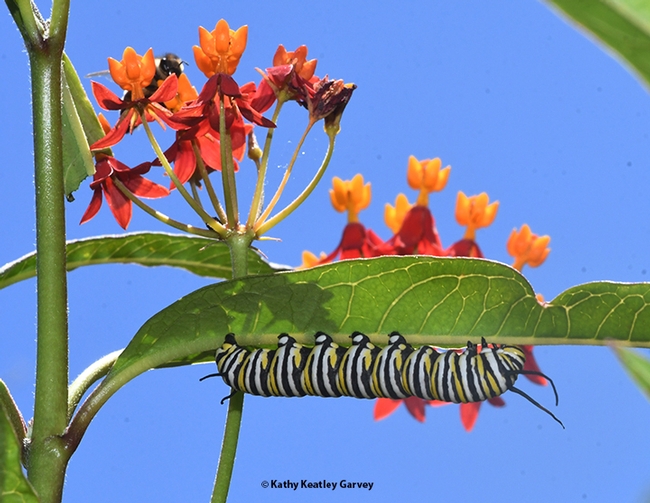
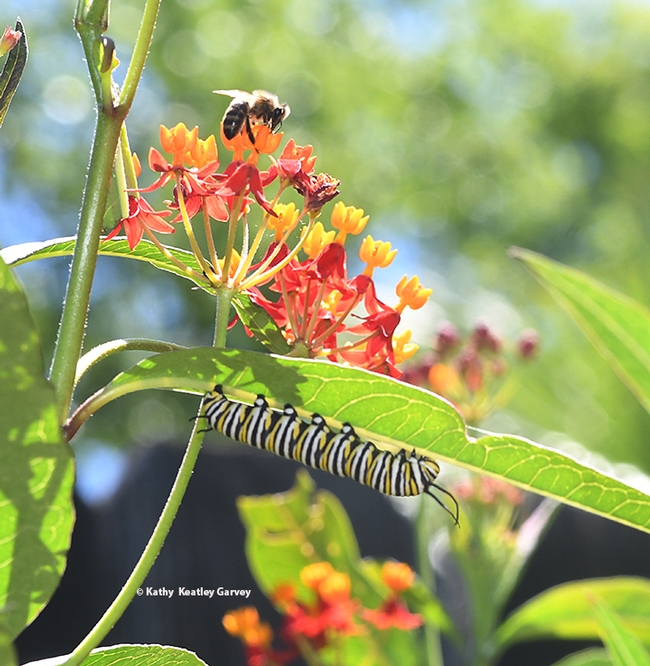
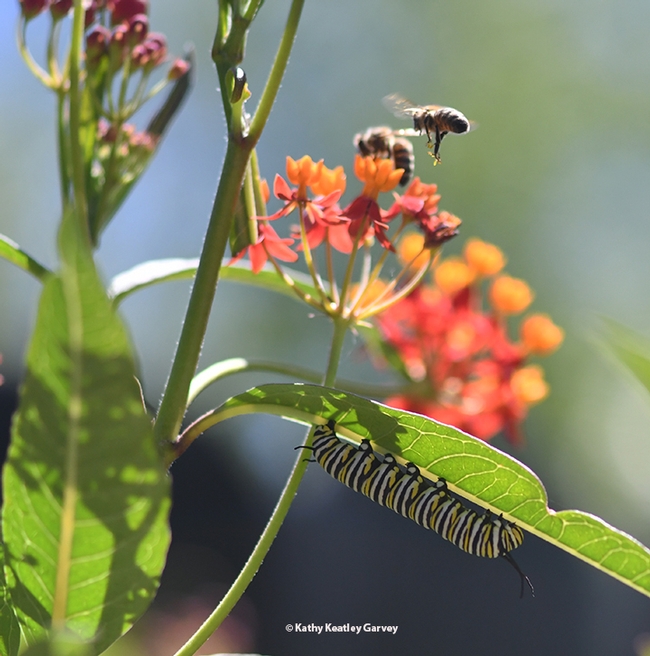
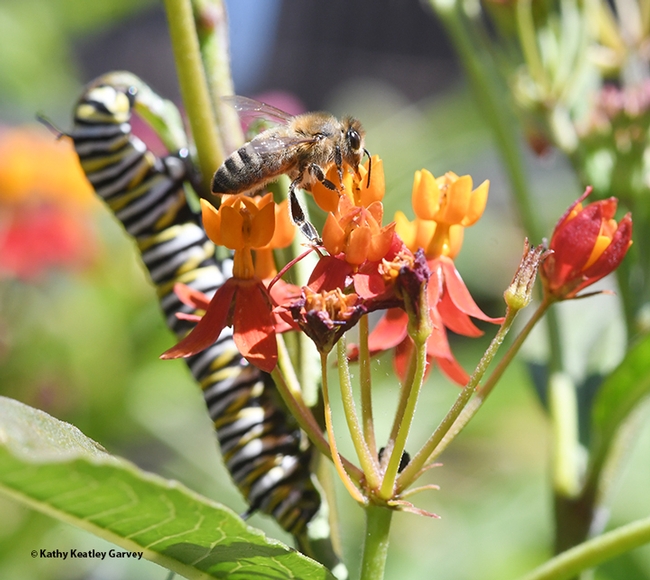
- Author: Kathy Keatley Garvey
You can't get any more Halloween than a bold (daring) jumping spider with orange spots!
This common North American spider was hanging out yesterday on our showy milkweed, Asclepias speciosa, trying to look like a spectator instead of a predator.
The orange spots indicate it's a juvenile Phidippus audax. As it matures, those spots will turn white. It can jump 10 to 15 times its body length, deploying its silk "lifeline" when it's jumping for prey or evading predators, according to Wikipedia. It hunts only in the daytime.
Yesterday, resplendent in its iridescent chelicerae (mouthparts or "fangs"), the eight-eyed, eight-legged dark hairy spider crawled around the broad leaves of the milkweed, sharing its home with assorted lady beetles, aphids, wasps and an occasional butterfly (Monarchs, Gulf Fritillaries and skippers).
It soaked up some sun and then apparently decided that the telephoto camera lens represented a clear and present danger, too bold and too daring.
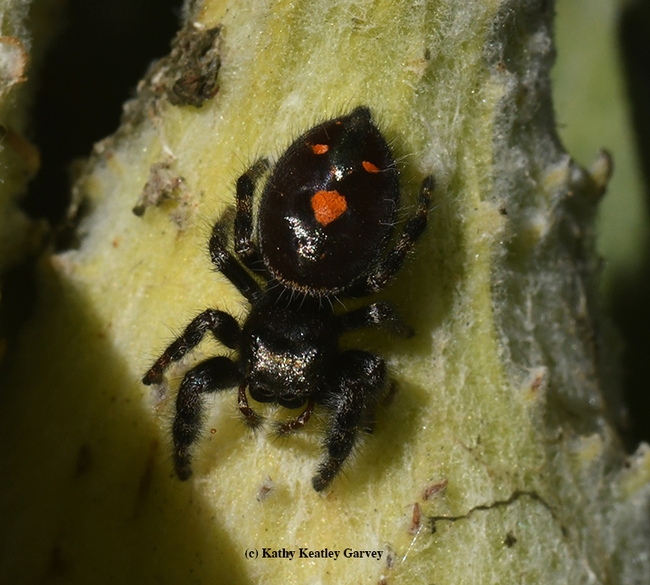
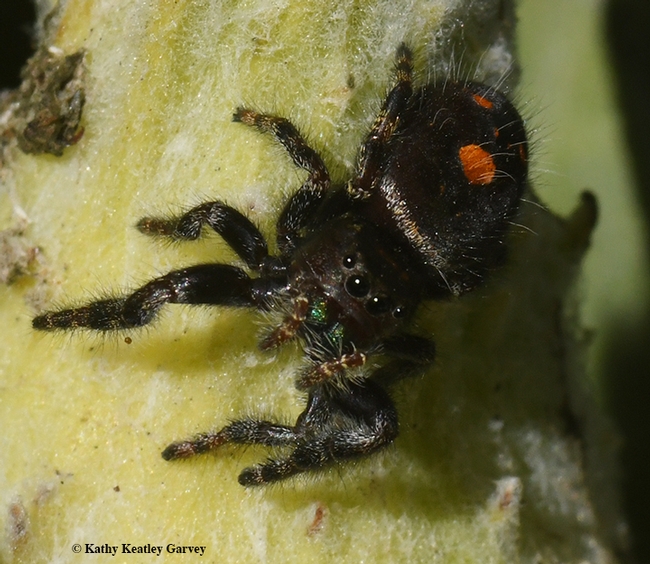
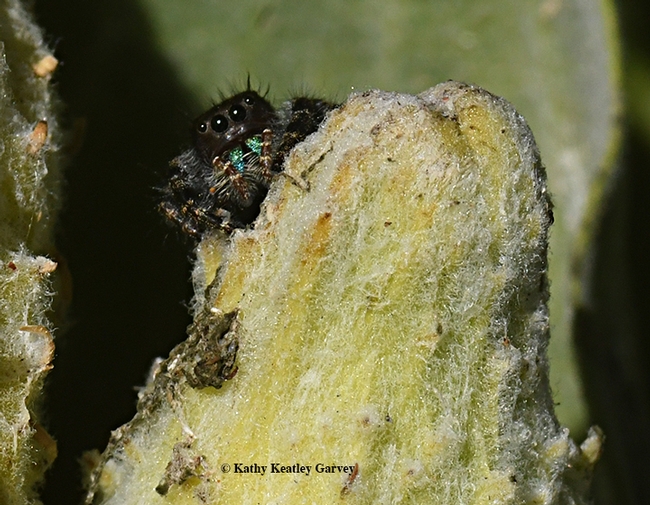
- Author: Kathy Keatley Garvey
A little haggard, a little worn, a little ragged, a little torn.
But there she was on Monday, Aug. 1, the first monarch of the season to lay eggs in our little pollinator garden in Vacaville, Calif.
She found the milkweed, but that was AFTER the aphids, milkweed bugs, praying mantids, assassin bugs and assorted spiders claimed it.
It's always a joy to see the majestic monarch fluttering through a pollinator garden. On Sunday, July 31, a male lingered for two hours, nectaring on the Mexican sunflower (Tithonia) as the male territorial longhorn bees tried to chase him away. No welcome mat for him! No place setting for him!
Then today, a female arrived, first stopping by the showy milkweed, Asclepias speciosa, to lay eggs and then fluttering over to the tropical milkweed, Asclepias curassavica, to lay more.
It's amazing how the monarchs, Danaus plexippus, know how to put their "resources" in multiple places. Like the idiom that cautions "don't put all your eggs in one basket," instinctively they seem to know that if they put all their resources in one place, they could lose them all. There's a better chance of offspring survival if they spread the eggs around.
We'll see.
